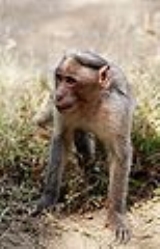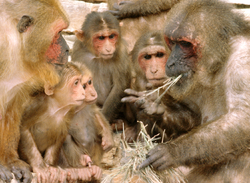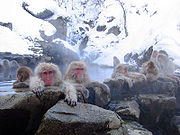
Macaque
Encyclopedia
The macaques constitute a genus (Macaca m) of Old World monkeys of the subfamily Cercopithecinae
.
s (genus Homo
), the macaques are the most widespread primate
genus, ranging from Japan
to Afghanistan
and, in the case of the barbary macaque
, to North Africa
. Twenty-two macaque species are currently recognised, and they include some of the monkeys best known to non-zoologists, such as the rhesus macaque
, Macaca mulatta, and the barbary macaque, M. sylvanus, a colony of which lives on the Rock of Gibraltar
. Although several species lack tails, and their common names therefore refer to them as ape
s, these are true monkeys, with no greater relationship to the true apes than any other Old World monkeys.
In some species skin folds join the second through fifth toes, almost reaching the first metatarsal
joint.
, particularly in the neuroscience
of visual perception
and the visual system
.
Nearly all (73-100%) pet and captive macaques are carriers
of the herpes B virus
. This virus
is harmless to macaques, but infections of humans, while rare, are potentially fatal, a risk that makes macaques unsuitable as pets.
A 2005 University of Toronto
study showed that urban performing macaques also carried simian foamy virus
, suggesting they could be involved in the species-to-species jump of similar retroviruses to humans.

 Genus Macaca
Genus Macaca
Prehistoric (fossil
) species:
Cercopithecinae
The Cercopithecinae are a subfamily of the Old World monkeys, that includes in its roughly 71 species the baboons, the macaques and the vervet monkeys...
.
Description
Aside from humanHuman
Humans are the only living species in the Homo genus...
s (genus Homo
Homo (genus)
Homo is the genus that includes modern humans and species closely related to them. The genus is estimated to be about 2.3 to 2.4 million years old, evolving from australopithecine ancestors with the appearance of Homo habilis....
), the macaques are the most widespread primate
Primate
A primate is a mammal of the order Primates , which contains prosimians and simians. Primates arose from ancestors that lived in the trees of tropical forests; many primate characteristics represent adaptations to life in this challenging three-dimensional environment...
genus, ranging from Japan
Japan
Japan is an island nation in East Asia. Located in the Pacific Ocean, it lies to the east of the Sea of Japan, China, North Korea, South Korea and Russia, stretching from the Sea of Okhotsk in the north to the East China Sea and Taiwan in the south...
to Afghanistan
Afghanistan
Afghanistan , officially the Islamic Republic of Afghanistan, is a landlocked country located in the centre of Asia, forming South Asia, Central Asia and the Middle East. With a population of about 29 million, it has an area of , making it the 42nd most populous and 41st largest nation in the world...
and, in the case of the barbary macaque
Barbary Macaque
The Barbary Macaque , or Common macaque, is a macaque with no tail. Found in the Atlas Mountains of Algeria and Morocco with a small population, of unknown origin, in Gibraltar, the Barbary Macaque is one of the best-known Old World monkey species. Besides humans, they are the only primates that...
, to North Africa
Maghreb
The Maghreb is the region of Northwest Africa, west of Egypt. It includes five countries: Morocco, Algeria, Tunisia, Libya, and Mauritania and the disputed territory of Western Sahara...
. Twenty-two macaque species are currently recognised, and they include some of the monkeys best known to non-zoologists, such as the rhesus macaque
Rhesus Macaque
The Rhesus macaque , also called the Rhesus monkey, is one of the best-known species of Old World monkeys. It is listed as Least Concern in the IUCN Red List of Threatened Species in view of its wide distribution, presumed large population, and its tolerance of a broad range of habitats...
, Macaca mulatta, and the barbary macaque, M. sylvanus, a colony of which lives on the Rock of Gibraltar
Rock of Gibraltar
The Rock of Gibraltar is a monolithic limestone promontory located in Gibraltar, off the southwestern tip of Europe on the Iberian Peninsula. It is high...
. Although several species lack tails, and their common names therefore refer to them as ape
Ape
Apes are Old World anthropoid mammals, more specifically a clade of tailless catarrhine primates, belonging to the biological superfamily Hominoidea. The apes are native to Africa and South-east Asia, although in relatively recent times humans have spread all over the world...
s, these are true monkeys, with no greater relationship to the true apes than any other Old World monkeys.
In some species skin folds join the second through fifth toes, almost reaching the first metatarsal
Metatarsus
The metatarsus or metatarsal bones are a group of five long bones in the foot located between the tarsal bones of the hind- and mid-foot and the phalanges of the toes. Lacking individual names, the metatarsal bones are numbered from the medial side : the first, second, third, fourth, and fifth...
joint.
Social behavior
Macaques have a very intricate social structure and hierarchy. If a macaque that is lower level in the social chain has eaten berries and there are none left for a higher level macaque, then the one higher in status can, within this social organization, remove the berries from the other monkey's mouth.Interaction with humans
Several species of macaque are used extensively in animal testingAnimal testing
Animal testing, also known as animal experimentation, animal research, and in vivo testing, is the use of non-human animals in experiments. Worldwide it is estimated that the number of vertebrate animals—from zebrafish to non-human primates—ranges from the tens of millions to more than 100 million...
, particularly in the neuroscience
Neuroscience
Neuroscience is the scientific study of the nervous system. Traditionally, neuroscience has been seen as a branch of biology. However, it is currently an interdisciplinary science that collaborates with other fields such as chemistry, computer science, engineering, linguistics, mathematics,...
of visual perception
Visual perception
Visual perception is the ability to interpret information and surroundings from the effects of visible light reaching the eye. The resulting perception is also known as eyesight, sight, or vision...
and the visual system
Visual system
The visual system is the part of the central nervous system which enables organisms to process visual detail, as well as enabling several non-image forming photoresponse functions. It interprets information from visible light to build a representation of the surrounding world...
.
Nearly all (73-100%) pet and captive macaques are carriers
Asymptomatic carrier
An asymptomatic carrier is a person or other organism that has contracted an infectious disease, but who displays no symptoms. Although unaffected by the disease themselves, carriers can transmit it to others...
of the herpes B virus
Herpes B Virus
Herpes Simian B virus is the endemic simplexvirus of macaque monkeys. B virus is an alphaherpesvirus, which consists of a subset of herpesviruses that travel within hosts using the peripheral nerves...
. This virus
Virus
A virus is a small infectious agent that can replicate only inside the living cells of organisms. Viruses infect all types of organisms, from animals and plants to bacteria and archaea...
is harmless to macaques, but infections of humans, while rare, are potentially fatal, a risk that makes macaques unsuitable as pets.
A 2005 University of Toronto
University of Toronto
The University of Toronto is a public research university in Toronto, Ontario, Canada, situated on the grounds that surround Queen's Park. It was founded by royal charter in 1827 as King's College, the first institution of higher learning in Upper Canada...
study showed that urban performing macaques also carried simian foamy virus
Simian foamy virus
The simian foamy virus is a spumavirus closely related to the Human Immunodeficiency Virus, HIV, the virus that can lead to AIDS. Its discovery in primates has led to some speculation that HIV may have been spread to the human species in Africa through contact with blood from apes, monkeys, and...
, suggesting they could be involved in the species-to-species jump of similar retroviruses to humans.
Species


- M. sylvanus group
- Barbary macaqueBarbary MacaqueThe Barbary Macaque , or Common macaque, is a macaque with no tail. Found in the Atlas Mountains of Algeria and Morocco with a small population, of unknown origin, in Gibraltar, the Barbary Macaque is one of the best-known Old World monkey species. Besides humans, they are the only primates that...
, Macaca sylvanus
- Barbary macaque
- M. nemestrina group
- Lion-tailed macaqueLion-tailed MacaqueThe lion-tailed macaque is an Old World monkey that is endemic to the Western Ghats of South India.-Physical Characteristics:...
, Macaca silenus - Southern pig-tailed macaqueSouthern Pig-tailed MacaqueThe southern pig-tailed macaque is a medium-sized Old World monkey found in the southern half of the Malay Peninsula , Borneo, Sumatra and Bangka Island. This omnivorous macaque is mostly found in forest, but will also enter plantations and gardens...
or Beruk, Macaca nemestrina - Northern pig-tailed macaqueNorthern Pig-tailed MacaqueThe northern pig-tailed macaque is a species of primate in the Cercopithecidae family. It is found in Bangladesh, Cambodia, China, India, Laos, Myanmar, Thailand, and Vietnam. Traditionally, it has been considered a subspecies of M. nemestrina...
, Macaca leonina - Pagai Island macaquePagai Island MacaqueThe Pagai Island macaque , also known as the Pagai macaque or Bokkoi, is an Old World monkey that is endemic to the Mentawai Islands off the west coast of Sumatra. It is listed as critically endangered on the IUCN Red List due to its ever-shrinking habitat. It formerly included the overall darker M...
, Macaca pagensis - Siberut macaqueSiberut MacaqueThe Siberut macaque is a vulnerable species of macaque, which is endemic to Siberut Island in Indonesia. It was formerly considered conspecific with M. pagensis , but this arrangement is polyphyletic. Both were formerly considered subspecies of M. nemestrina....
, Macaca siberu - Moor macaqueMoor MacaqueThe moor macaque is a macaque with brown/black body fur with a pale rump patch and pink bare skin on the rump. It is about 50-58.5 cm and eats figs, bamboo seeds, buds, sprouts, invertebrates and cereals in tropical rainforests...
, Macaca maura - Booted macaqueBooted MacaqueThe booted macaque is a macaque of the Sulawesi island, Indonesia. This Old World monkey is diurnal and spends most of the day in the trees.It is 50–59 cm long plus a tail of 35–40 cm....
, Macaca ochreata - Tonkean macaqueTonkean MacaqueThe Tonkean black macaque or Tonkean macaque is a species of primate in the Cercopithecidae family. It is endemic to central Sulawesi and the nearby Togian Islands in Indonesia. It is threatened by habitat loss....
, Macaca tonkeana - Heck's macaqueHeck's MacaqueHeck's macaque is a macaque of the Sulawesi island, Indonesia. This Old World monkey is diurnal.Heck's macaque feeds on fruits.-External links:*...
, Macaca hecki - Gorontalo macaqueGorontalo MacaqueThe Dumoga-bone Macaque or Gorontalo macaque is a species of primate in the Cercopithecidae family. It is endemic to the island of Sulawesi in Indonesia....
, Macaca nigriscens - Celebes crested macaqueCelebes Crested MacaqueThe Celebes crested macaque , also known as the crested black macaque, Sulawesi crested macaque, or the black ape, is an Old World monkey that lives in the northeast of the Indonesian island of Sulawesi as well as on smaller neighboring islands.-Description:Its skin and hairless face is, with the...
, Macaca nigra
- Lion-tailed macaque
- M. fascicularis group
- Crab-eating macaqueCrab-eating MacaqueThe Crab-eating macaque is a cercopithecine primate native to Southeast Asia. It is also called the "long-tailed macaque", and is referred to as the "cynomolgus monkey" in laboratories.-Etymology:...
, Macaca fascicularis - Stump-tailed macaqueStump-tailed MacaqueThe stump-tailed macaque , also called the bear macaque, is a species of macaque found in Southern Asia. In India, it is found in south of the Brahmaputra river, in northeastern part of the country.Its range in India extends from Assam and Meghalaya to eastern Aruanchal Pradesh, Nagaland, Manipur,...
, Macaca arctoides
- Crab-eating macaque
- M. mulatta group
- Rhesus macaqueRhesus MacaqueThe Rhesus macaque , also called the Rhesus monkey, is one of the best-known species of Old World monkeys. It is listed as Least Concern in the IUCN Red List of Threatened Species in view of its wide distribution, presumed large population, and its tolerance of a broad range of habitats...
, Macaca mulatta - Formosan rock macaqueFormosan Rock MacaqueThe Formosan Rock Macaque is a macaque endemic to the island of Taiwan and has been introduced to Japan. Besides humans, Formosan Rock Macaques are the only native primates living in Taiwan.-Physical Characteristics:...
, Macaca cyclopis - Japanese macaqueJapanese MacaqueThe Japanese macaque , historically known as saru , but now known as Nihonzaru to distinguish it from other primates, is a terrestrial Old World monkey species native to Japan....
, Macaca fuscata
- Rhesus macaque
- M. sinica group
- Toque macaqueToque MacaqueThe toque macaque is a reddish-brown coloured Old World monkey endemic to both Sri Lanka, where it is locally known as the 'Rilewa' or 'Rilawa'...
, Macaca sinica - Bonnet macaqueBonnet MacaqueThe bonnet macaque is a macaque endemic to southern India. Its distribution is limited by the Indian Ocean on three sides and the Godavari and Tapti Rivers along with a related competing species of rhesus macaque in the north....
, Macaca radiata - Assam macaqueAssam MacaqueThe Assam macaque is a macaque of the Old World monkey family native to South and Southeast Asia. Since 2008, the species is listed as Near Threatened by IUCN, as it is experiencing significant declines due to hunting, habitat degradation and fragmentation.- Characteristics :The Assam macaque has...
, Macaca assamensis - Tibetan macaqueTibetan macaqueThe Tibetan macaque , also known as the Chinese stump-tailed macaque or Milne-Edwards' macaque, is found from eastern Tibet east to Guangdong and north to Shaanxi in China and has recently been reported from north-eastern India. This species lives in subtropical forests at altitude that range from...
, Macaca thibetana - Arunachal macaqueArunachal MacaqueThe Arunachal macaque , a relatively large brown primate with a comparatively short tail, is a macaque native to Arunachal Pradesh in north-eastern India. Its species name comes from Munzala as it was called by the Dirang Monpa tribe...
, Macaca munzala
- Toque macaque
Prehistoric (fossil
Fossil
Fossils are the preserved remains or traces of animals , plants, and other organisms from the remote past...
) species:
- Macaca anderssoniMacaca anderssoniMacaca anderssoni is a prehistoric species of Macaque from the Pleistocene of Japan. It weighed between 7.5 kg and 10.5 kg....
Schlosser, 1924 - Macaca jiangchuanensisMacaca jiangchuanensisMacaca jiangchuanensis was a prehistoric Macaque from the early Holocene of China....
Pan et al., 1992 - Macaca libycaMacaca libycaMacaca libyca was a prehistoric Macaque from the Late Miocene of Egypt...
Stromer, 1920 - Macaca majoriMacaca majoriMacaca majori was a prehistoric Macaque from the Pleistocene of Sardinia, Italy...
Schaub & Azzaroli in Comaschi Caria, 1969 (sometimes included in M. sylvanus)
See also
- Herpes B virusHerpes B VirusHerpes Simian B virus is the endemic simplexvirus of macaque monkeys. B virus is an alphaherpesvirus, which consists of a subset of herpesviruses that travel within hosts using the peripheral nerves...
- Kayabukiya TavernKayabukiya TavernThe is a traditional-style Japanese "sake-house" restaurant located in the city of Utsunomiya, north of Tokyo, Japan. The location attracted international attention in 2008 when the Western media reported the tavern and its news movies were uploaded to YouTube.The tavern's owner, Kaoru Otsuka,...
- Controversies of the United States Senate election in Virginia, 2006Controversies of the United States Senate election in Virginia, 2006The Controversies of the United States Senate election in Virginia, 2006 involved both Republican incumbent senator George Allen and Democrat opponent Jim Webb...
- George Allen's "Macaque Controversy" - Macaque brain development timelineMacaque brain development timelineSpecies: Macaca mulattaFamily: Cercopithecidae Order: PrimatesGestation: 165 daysDates in days Day Event Reference 30 retinal ganglion cell generation - start of neurogenesis Robinson and Dreher 30...

